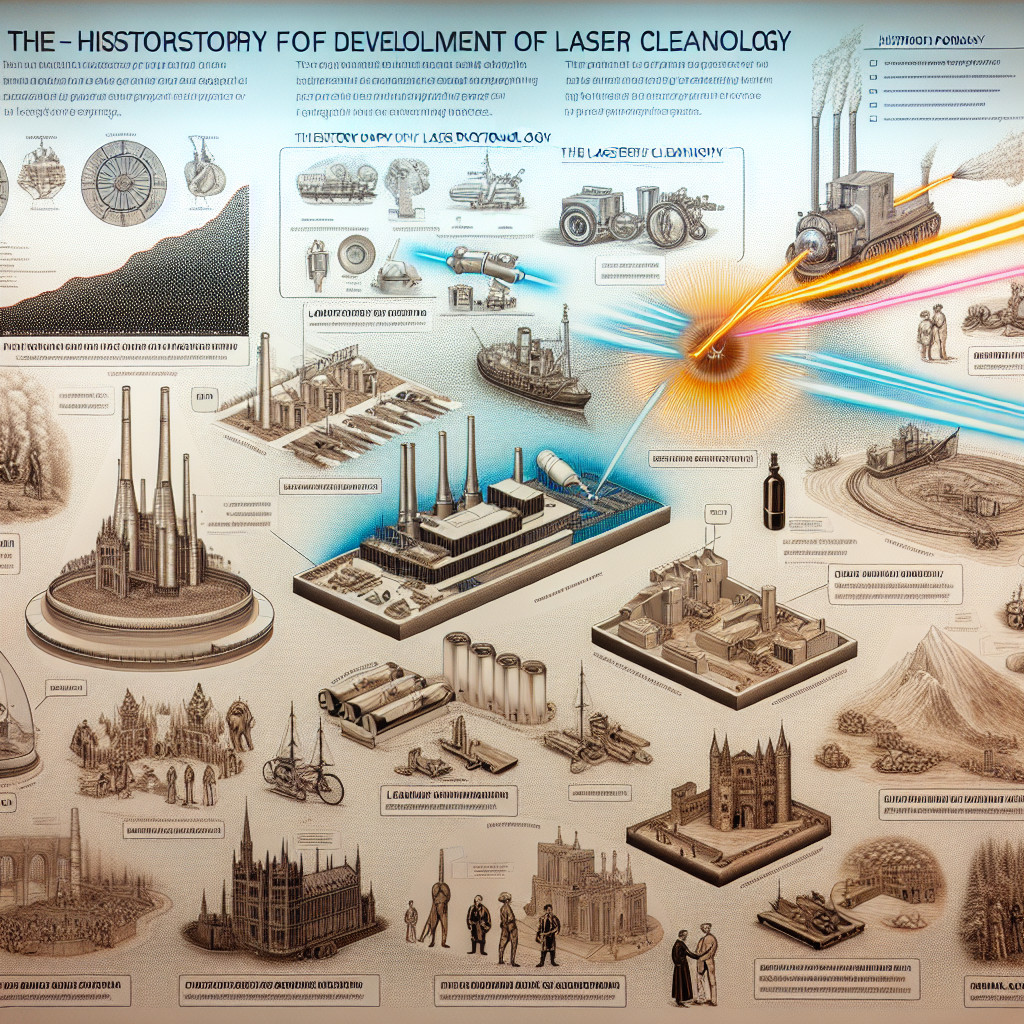
The history and development of laser cleaning technology
- The origins of laser cleaning technology
- The early applications of laser cleaning
- The evolution of laser cleaning technology
- The advantages of laser cleaning over traditional methods
- The environmental benefits of laser cleaning
- The role of laser cleaning in the automotive industry
- The training and certification required for operating laser cleaning equipment
- The regulations and standards governing laser cleaning technology
The origins of laser cleaning technology
One of the key pioneers in the development of laser cleaning technology was Theodore Maiman, who built the first working laser in 1960. Maiman’s invention paved the way for further research into the potential uses of lasers, including their application in cleaning surfaces.
In the 1970s, researchers began to explore the idea of using lasers to remove contaminants from surfaces without causing damage. This led to the development of the first laser cleaning systems, which were initially used in industrial settings to clean metal surfaces.
Over the years, laser cleaning technology has continued to evolve and improve, with new advancements in laser technology allowing for more precise and efficient cleaning. Today, laser cleaning systems are used in a wide range of industries, from aerospace and automotive to electronics and conservation.
One of the key advantages of laser cleaning technology is its ability to remove contaminants without the need for harsh chemicals or abrasive materials. This makes it an environmentally friendly and cost-effective solution for cleaning a variety of surfaces.
In addition to its cleaning capabilities, laser technology also offers other benefits, such as the ability to selectively remove specific contaminants or coatings from surfaces. This level of precision makes laser cleaning technology ideal for applications where delicate or intricate surfaces need to be cleaned.
Overall, can be traced back to the early experiments with lasers in the 20th century. Since then, this innovative technology has continued to evolve and improve, offering a versatile and efficient solution for cleaning a wide range of surfaces.
#laser #cleaning #technology #innovation #surface #contaminants #precision #environmentallyfriendly #industrial #applications
frazy kluczowe:
– laser cleaning technology origins
– history of laser cleaning technology
– benefits of laser cleaning technology
– applications of laser cleaning technology
– evolution of laser cleaning technology
The early applications of laser cleaning
Early applications of laser cleaning:
1. Industrial cleaning: In the early days of laser cleaning, it was primarily used for industrial cleaning tasks such as removing rust, paint, and other contaminants from metal surfaces. The precision and speed of laser cleaning made it an attractive alternative to traditional cleaning methods.
2. Art restoration: Another early application of laser cleaning was in the field of art restoration. Laser cleaning proved to be a gentle and effective way to remove dirt, grime, and other pollutants from delicate artworks without causing damage to the underlying surface.
3. Historical preservation: Laser cleaning was also used in the preservation of historical monuments and buildings. By carefully removing layers of dirt and pollutants, laser cleaning helped to restore the original appearance of these structures and prolong their lifespan.
4. Medical device cleaning: Laser cleaning was also used in the medical industry for cleaning and sterilizing medical devices. The precision and non-contact nature of laser cleaning made it ideal for removing contaminants from delicate instruments without causing damage.
5. Electronics manufacturing: In the electronics industry, laser cleaning was used to remove residues and contaminants from circuit boards and other electronic components. The precision and efficiency of laser cleaning helped to improve the quality and reliability of electronic devices.
6. Aerospace industry: Laser cleaning found early applications in the aerospace industry for cleaning and maintenance of aircraft components. The ability of laser cleaning to remove contaminants without damaging the underlying material made it a valuable tool for ensuring the safety and performance of aircraft.
7. Automotive industry: Laser cleaning was also used in the automotive industry for cleaning and surface preparation of car parts. The speed and precision of laser cleaning helped to improve the quality of automotive components and reduce production costs.
As laser cleaning technology continues to advance, its applications are expanding into new industries and tasks. From cleaning historical artifacts to preparing surfaces for painting, laser cleaning has become an essential tool in a wide range of applications.
#laser #cleaning #technology #applications #industrial #art #restoration #preservation #medical #electronics #aerospace #automotive
frazy kluczowe:
– early applications of laser cleaning technology
– industrial cleaning with laser technology
– laser cleaning in art restoration
– historical preservation using laser technology
– medical device cleaning with lasers
– laser cleaning in electronics manufacturing
– aerospace industry applications of laser cleaning
– automotive industry and laser cleaning technology
The evolution of laser cleaning technology
History of laser cleaning technology
The concept of using lasers for cleaning purposes dates back to the 1960s, when researchers first began experimenting with the idea of using laser beams to remove surface contaminants. Early laser cleaning systems were bulky and expensive, making them impractical for widespread use. However, as laser technology advanced and became more affordable, the potential for laser cleaning technology began to be realized.
In the 1980s and 1990s, significant advancements were made in laser technology, leading to the development of more compact and efficient laser cleaning systems. These systems were capable of removing a wide range of contaminants, including rust, paint, and grease, from a variety of surfaces. As a result, laser cleaning technology began to gain traction in industries such as automotive manufacturing, aerospace, and electronics.
Current applications of laser cleaning technology
Today, laser cleaning technology is used in a wide range of industries and applications. In the automotive industry, laser cleaning is used to remove paint and rust from car bodies, resulting in a more efficient and environmentally friendly cleaning process. In the aerospace industry, laser cleaning is used to remove contaminants from aircraft components, ensuring optimal performance and safety. In the electronics industry, laser cleaning is used to remove solder and flux residues from circuit boards, improving product quality and reliability.
One of the key advantages of laser cleaning technology is its ability to remove contaminants without damaging the underlying surface. Unlike traditional cleaning methods, which can be abrasive or corrosive, laser cleaning is a non-contact process that is gentle on delicate surfaces. This makes laser cleaning ideal for cleaning sensitive components such as optical lenses, semiconductor wafers, and medical devices.
Future potential of laser cleaning technology
As laser technology continues to advance, the potential for laser cleaning technology is only expected to grow. Researchers are currently exploring new applications for laser cleaning, such as removing contaminants from cultural artifacts, restoring historical buildings, and cleaning up hazardous waste sites. Additionally, advancements in laser technology are making laser cleaning systems more affordable and accessible, opening up new opportunities for small businesses and consumers to take advantage of this innovative cleaning method.
| Year | Advancement |
|---|---|
| 1960s | First experiments with laser cleaning |
| 1980s | Development of compact laser cleaning systems |
| 1990s | Advancements in laser technology for cleaning applications |
Overall, the evolution of laser cleaning technology has been marked by significant advancements in laser technology, leading to more efficient and versatile cleaning systems. With its ability to remove contaminants without damaging surfaces, laser cleaning technology is poised to become an essential tool in a wide range of industries and applications.
#laser #cleaning #technology #evolution #applications #future
długiego ogona: laser cleaning technology advancements, laser cleaning technology applications, laser cleaning technology history, laser cleaning technology future potential.
The advantages of laser cleaning over traditional methods
Efficiency
- Laser cleaning is incredibly efficient, allowing for faster and more thorough cleaning compared to traditional methods. The precision of laser technology ensures that even the smallest and most delicate surfaces can be cleaned with ease.
- Traditional cleaning methods often require the use of harsh chemicals and abrasive materials, which can be time-consuming and labor-intensive. Laser cleaning eliminates the need for these materials, making the process much quicker and more efficient.
Environmental impact
- One of the biggest advantages of laser cleaning is its minimal environmental impact. Traditional cleaning methods often involve the use of harmful chemicals that can pollute the air and water. Laser cleaning, on the other hand, is a clean and eco-friendly process that produces no waste or emissions.
- By eliminating the need for chemicals and abrasive materials, laser cleaning helps reduce the carbon footprint of industries and promotes sustainability.
Cost-effectiveness
- While the initial investment in laser cleaning technology may be higher than traditional methods, the long-term cost savings are significant. Laser cleaning requires less maintenance and fewer consumables, resulting in lower operating costs over time.
- Additionally, the efficiency of laser cleaning means that less time and labor are required for cleaning tasks, further reducing costs for businesses.
In conclusion, laser cleaning offers a wide range of advantages over traditional cleaning methods, including increased efficiency, reduced environmental impact, and cost-effectiveness. As industries continue to prioritize sustainability and efficiency, laser cleaning is likely to become the standard for cleaning applications in the future.
#laser cleaning, advantages, efficiency, environmental impact, cost-effectiveness
#revolutionary technology, increased efficiency, reduced environmental impact, minimal environmental impact, cost savings, sustainability, laser technology, traditional methods, cleaning tasks, cleaning applications, standard.
The environmental benefits of laser cleaning
Reduced chemical usage
One of the primary environmental benefits of laser cleaning is the significant reduction in chemical usage. Traditional cleaning methods often rely on the use of harsh chemicals that can be harmful to both human health and the environment. By using a laser beam to remove contaminants, laser cleaning eliminates the need for these chemicals, reducing the risk of pollution and minimizing the impact on ecosystems.
Minimal waste production
Another key advantage of laser cleaning is the minimal waste production associated with the process. Traditional cleaning methods can generate large amounts of waste, including used cleaning agents and contaminated materials. In contrast, laser cleaning produces minimal waste, as the contaminants are vaporized and removed from the surface without leaving behind any residue. This not only reduces the amount of waste that needs to be disposed of but also minimizes the risk of contamination to soil and water sources.
Energy efficiency
Laser cleaning is also more energy-efficient than traditional cleaning methods. The precision of the laser beam allows for targeted cleaning, reducing the amount of energy required to remove contaminants from surfaces. Additionally, laser cleaning can be automated, further increasing energy efficiency by reducing the need for manual labor. This energy efficiency not only reduces the environmental impact of the cleaning process but also helps companies save on energy costs in the long run.
Conclusion
Overall, laser cleaning offers a range of environmental benefits that make it a more sustainable choice for industries looking to reduce their environmental impact. By eliminating the need for harsh chemicals, minimizing waste production, and increasing energy efficiency, laser cleaning is helping to protect the environment and promote a cleaner, healthier planet for future generations.
#environment #laser #cleaning #sustainability #energyefficiency #wastemanagement
słowa kluczowe: environmental benefits, laser cleaning, sustainable cleaning, energy efficiency, waste reduction
frazy kluczowe: benefits of laser cleaning for the environment, eco-friendly cleaning solutions, reducing chemical usage in cleaning, minimizing waste production, energy-efficient cleaning methods.
The role of laser cleaning in the automotive industry
Benefits of laser cleaning in the automotive industry:
– 🌟 Precision: Laser cleaning allows for precise removal of contaminants without damaging the underlying surface.
– 🌟 Efficiency: This method is faster and more efficient than traditional cleaning methods, saving time and labor costs.
– 🌟 Environmentally friendly: Laser cleaning is a non-contact and chemical-free process, reducing waste and environmental impact.
– 🌟 Versatility: Laser cleaning can be used on a variety of materials, including metal, plastic, and glass.
Applications of laser cleaning in the automotive industry:
– 🚗 Rust removal: Laser cleaning can effectively remove rust from car parts, extending their lifespan.
– 🚗 Paint stripping: This method is ideal for removing old paint from vehicles before repainting.
– 🚗 Weld cleaning: Laser cleaning can clean welds on car parts, improving their appearance and quality.
– 🚗 Surface preparation: Laser cleaning is used to prepare surfaces for bonding, welding, or coating.
Overall, laser cleaning has become an essential tool in the automotive industry, providing a cost-effective and environmentally friendly solution for surface cleaning and preparation. As technology continues to advance, we can expect to see even more applications of laser cleaning in the automotive sector.
#laser #cleaning #automotive #industry
Keywords: laser cleaning, automotive industry, precision, efficiency, environmentally friendly, rust removal, paint stripping, weld cleaning, surface preparation.
Long-tail phrases:
– Laser cleaning in automotive manufacturing
– Benefits of laser cleaning in the automotive sector
– Applications of laser cleaning technology in the automotive industry.
The training and certification required for operating laser cleaning equipment
1. **Basic laser safety training**: Before operating any laser equipment, individuals must undergo basic laser safety training to understand the potential hazards associated with laser technology. This training covers topics such as laser classification, beam hazards, and safety protocols.
2. **Specific equipment training**: In addition to general laser safety training, operators must receive specific training on the operation of the laser cleaning equipment they will be using. This training includes instruction on how to set up the equipment, calibrate the laser beam, and safely clean different types of surfaces.
3. **Hands-on experience**: To become proficient in operating laser cleaning equipment, individuals must gain hands-on experience under the supervision of a qualified trainer. This practical experience allows operators to develop the skills necessary to effectively use the equipment.
4. **Certification**: Once individuals have completed the necessary training and gained sufficient experience, they can obtain certification to operate laser cleaning equipment. Certification demonstrates that operators have met the required standards for safety and proficiency in using the equipment.
5. **Continuing education**: To maintain their certification, operators must participate in continuing education programs to stay up-to-date on the latest advancements in laser cleaning technology and safety protocols.
In conclusion, operating laser cleaning equipment requires specialized training and certification to ensure safety and efficiency. By following the proper training protocols and obtaining certification, operators can effectively use this powerful tool in various industries.
#laser #cleaning #equipment #training #certification
frazy kluczowe:
– laser cleaning equipment training and certification
– laser safety training for operators
– hands-on experience with laser cleaning equipment
– certification requirements for laser operators
– continuing education in laser technology
The regulations and standards governing laser cleaning technology
Regulations
- The Occupational Safety and Health Administration (OSHA) in the United States has specific regulations regarding the use of lasers in the workplace. Employers must provide training to employees on the safe operation of laser cleaning equipment and ensure that proper safety measures are in place.
- The International Electrotechnical Commission (IEC) has developed standards for laser safety, including guidelines for the classification of lasers based on their potential hazards. These standards help ensure that laser cleaning equipment meets certain safety requirements.
- In Europe, the European Laser Association (ELA) provides guidelines for the safe use of lasers in various applications, including cleaning. These guidelines help ensure that laser cleaning technology is used responsibly and safely.
Standards
- ISO 11553:2013 specifies safety requirements for the design and construction of laser processing machines, including laser cleaning equipment. Compliance with this standard helps ensure that laser cleaning technology is safe for use.
- ASTM F2847-19 provides guidelines for the safe use of lasers in industrial applications, including cleaning. Adhering to these guidelines helps ensure that laser cleaning equipment meets certain quality and safety standards.
- ANSI Z136.1-2014 sets forth safety requirements for the use of lasers in various applications, including cleaning. Compliance with this standard helps ensure that laser cleaning technology is used safely and responsibly.
In conclusion, laser cleaning technology is subject to regulations and standards to ensure its safe and proper use. Employers and users of laser cleaning equipment must adhere to these regulations and standards to protect themselves and others from potential hazards.
#laser #cleaning #technology #regulations #standards #safety #OSHA #IEC #ELA #ISO #ASTM #ANSI
“regulations and standards governing laser cleaning technology”, “safe use of lasers in industrial applications”, “compliance with safety requirements for laser cleaning equipment”
Jeśli interesują Cię tanie sponsorowane publikacje SEO bez pośredników - skontaktuj się z nami:
Tel. 505 008 289
Email: ceo@codeengineers.com
- IT audit – What is it and why it is worth carrying out? - 1 October 2025
- The history and development of laser cleaning technology - 11 April 2024
Łukasz Woźniakiewicz
Nazywam się Łukasz Woźniakiewicz, jestem właścicielem i CEO w Codeengineers.com, agencji marketingu internetowego oferującej między innymi takie usługi jak pozycjonowanie stron/sklepów internetowych, kampanie reklamowe Google Ads. Jeśli interesują Cię tanie sponsorowane publikacje SEO bez pośredników - skontaktuj się z nami: Tel. 505 008 289 Email: ceo@codeengineers.com
kobiece smokingi
You May Also Like

Cheap winter jackets for children – fashionable jackets for every budget
4 February 2021
Gay porn videos – entertainment on the weekend
25 June 2021
